Text
Haven't come across any secrets like that but... I have had some wild stories of ancestors I habe come across over the years. And I am learning more all the time.
Sorry I haven't been active much. I've been working on my family tree, because curiosity, and ya'll...the SECRETS I've been digging up!!
Found out my aunt was not my granddaddy's baby. Which would explain why she was the only child out of 10 to not get the famous baby blue eyes. I just thought genetics fucked her out of that.
Found out my uncle got married (then promptly divorced) when he was stationed in GERMANY and I have a whole ass German cousin.
Grandma celebrated the wrong birthday her entire life! She was 10 days off lol.
This shit is better than when I did the DNA test hahaha.
15 notes
·
View notes
Text
This blog may of interest to you all.
Mystery of Frances Appleton Packard
This past June I wrote about the importance of LGBTQ+ ancestors, stating that there are more queer ancestors within my family tree, and pointed out my fourth cousin five times removed, Frances Appleton Packard (1836-1902), noting that she "was always listed as single and never noted as marrying anyone, which can be a clue that the person is a queer individual". [1] In this post, I'd like to focus on her life.
Reprinted from my Packed with Packards! WordPress.
Frances was born in Brunswick, a town within Cumberland County, Maine on March 28, 1836 to Alpheus Spring Packard, Sr., a professor of Greek and Latin at Bowdoin College, and Frances Elizabeth Appleton, said to be a "woman of rare excellence". Unfortunately, when Frances A. was three years old, her mother would die for reasons not yet known. Frances A. next appears in the 1850 census, living with her father, Alpheus Sr., her five brothers (Charles A., William A., George L., Alpheus Jr., Robert L.), her stepmother Caroline W. Bartels (Alpheus Sr.'s second wife), and two boarders: 12-year-old George McLellan and 17-year-old Joanna Sillers. By 1860, however, she would not be living in the same household as her parents. Where she was living that year remains a mystery. But, one can make the supposition that she was still living in Brunswick, as she was living with her family in 1870 with her father and stepmother. This would be unchanged by 1880, as she still lived in Brunswick with her parents and an 18-year-old servant named Margaret Cusick in the household. [2]
Further evidence of her residence in Brunswick is made clear by one document: the school catalogue of Abbott Female Academy. She attended there between 1851 and 1852. She was among many married women, many of whom were from towns in New England or elsewhere. Abbott Academy, based in Andover, Massachusetts, was a well-known independent boarding prep school which was aimed at educating young women, with women proving key to its success, and was beginning to develop its robust curriculum. She would not be a student there the following term, from 1852 to 1853. She would only be briefly mentioned elsewhere, and additional records show that she was living in Bath, Maine (first on 21 Linden and later on 894 Washington), through the 1890s and into the early 1900s. In these records, she is never noted as marrying anyone else, always shown noted as being unmarried. [3] She would die on July 20, 1902 in Bath from bronchitis pneumonia and be noted as a housekeeper:
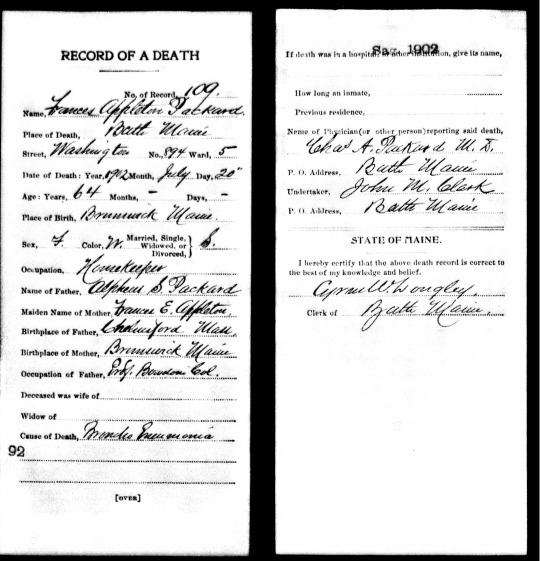
This image combines records from Maine, U.S., Death Records, 1761-1922 for Frances Appleton Packard, 1902, P, Maine State Archives; Cultural Building, 84 State House Station, Augusta, ME 04333-0084; 1892-1907 Vital Records; Roll Number: 43, Images 1-2. Charles, her brother, is noted as providing information about her.
She would be buried in Pine Grove Cemetery alongside her parents. Her Find A Grave entry only says two words currently: "Never married." [4] There's much more that can be said about her, however. A search on newspapers.com uncovered an obituary in the Sun-Journal which described her as a "woman of culture", a "deep student of literature" and member of the Fortnightly club. It also notes that she lived in Brunswick from her birth, in 1836 until the death of her father in 1884, and then moved to Bath, where she lived, meeting "many warm-hearted friends" which he kept until her death. It further notes her membership in the Congregational Church of Brunswick and later in the Winter street church in Bath. She was noted as dying, at the age of 63, at the home of her brother Charles who lived in Bath as well. Other notices pointed out that William, the sister of Frances, would administer his estate. [5]
We also learn, from the newspapers, that Frances visited the Bath Military and Naval Orphan Asylum in February 1898, where it turns out she worked as a "lady visitor" since at least January 1895. She is not to be confused with Frances Elizabeth Packard (1880-1971), daughter of Alpheus Jr. (Frances A.'s brother) and Elizabeth Derby Walcott who was said to be a "remarkably interesting young woman" who went on a trip to Europe, Asia, and Africa, from 1898 to 1899, and reportedly had "many friends" in Auburn and Lewiston. As for Frances A., one article confirmed her trip to Liverpool in 1899. She was clearly more than someone who was unmarried whose nickname was purportedly "Fanny", but a person who had a full life. [6]
The Bath Military and Naval Orphan Asylum was a place that helped out soldiers' orphans, and "half orphans of officers, soldiers, seamen and marines" who died while in combat or from wounds, injuries, or disease. This may be why Frances A. was listed as a housekeeper on her death record. It also included soldiers’ and sailor’s orphan children and grandchildren of any gender, specifically veterans of the Civil War. By January 1903, there were 69 children in the asylum plus 18 who were admitted and 25 taken in by other homes or relatives. Some children had been "farmed to outside homes" but came back to the asylum for "one reason or another".
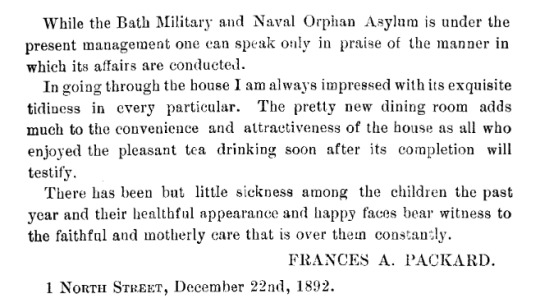
In 1892, Frances A. voices her views on the aforementioned asylum in 1892 and shows that she is impressed by it [7]
In sum, much of the life of Frances Appleton Packard remains a mystery, complicated by the fact there were others who had similar names, leading to a propensity of false drops. Additionally, while she was noted as single throughout her life, I could find no indication that she ever had a partner. The supposition, based on what I said at the beginning of this post, that those listed as single may be queer is still a good one, but in the case of Frances A., all we can say is that she was single and unmarried throughout her life, as no evidence points to anything else. After all, thought her life, Maine had in place a sodomy law which imprisoned people for ten years, after a revision in 1840, for the crime of sodomy (anal sex, oral sex, or bestiality), laws which are usually used against gay or lesbian people. It would only be repealed in 1976. Even so, some have said that Maine has a "rich LGBT history that is relatively unknown". Interestingly, Brunswick is among the towns recommended for where LGBTQ people should move, while Bath is not. The exact history of LGBTQ people in those towns is still fuzzy, although one source said that "rural Maine gays who had little support in their small towns." That was likely the case for Brunswick and Bath, perhaps more for the latter than the former. [8] In sum, the story of Frances A., living in a town based in shipbuilding (Bath) and the center of activity for the Pejepscot region (Brunswick) remains unwritten, but this article is just the start.
© 2023 Burkely Hermann. All rights reserved.
Notes
[1] There are other ancestors that I believe might be gay or otherwise queer, since they never married: my great-granduncles Harold "Harry" Cyrus Packard (1907-1975), Herbert Miles Packard (1898-1966), and Thomas "Tom" Theodore Packard (1902-1975) (this would be funny as he was apparently staunchly Republican), my great-grandaunts Olive Martha Packard (1896-1969) and Rachel May Packard (1900-1933), my second great-uncle Joseph B. Mills (1844-1900), my first cousin two times removed Giles Franklin Whitley (1911-1970) who died in 1970. The same is the case for my great-granduncle Joseph Winfield Packard (1885-1910), but that is no surprise as he only lived to the age of 24 before a freight train took his life. The same is the case for my first cousin three times removed Harry Tilson Packard (1879-1915), my first cousin three times removed, who died at the age of 36 in Los Angeles, and my second great aunt Mary M. Packard (1862-1887) who died at only 24 years old. I also have a nonbinary cousin, whose name I won't mention here, and on that note, I'd love to find some nonbinary ancestors, although that could be a challenge. There's also the interesting fact that my second great-grandaunt Margaret "Maggie" E. Mills (1854-1920) and father of great-grandaunt Thomas H. Crosgrove (b. 1858) only had a child when they adopted Mabel Hattie Packard (1892-1961), my great-grandaunt who is the child of Cyrus Winfield Packard (1852-1924) and Dorothy "Dora" Ann Mills (1849-1895), adopted by Thomas and Mabel at age 3. Also, Mary Jane Mills (b. 1854) my 2nd great-grand aunt was not married, from the little we know about her, nor was my second great-grand uncle, William Mills (b. 1861), my first cousin three times removed, Joseph Arthur Packard (1891-1911) who died at age 20, my first cousin three times removed, Walter Archie Packard (1903-1928) who died at age 25 when he was crushed by an elevator in the Montgomery Ward building in Albany. Additionally, my second great-granduncle B. Fred "Freddie" Packard (1858-1884) never married, nor did my first cousin four times removed Eva L. Packard (1876-1967), living in Kansas City for over 50 years, my first cousin four times removed Martha Elvira Packard (1880-1957), living in Kansas City like her sister Eva. The same is the case for my fourth great-grandaunt Ruby Packard (1799-1871) who never married and died of old age or my fourth great-grandaunt Sally Packard (1792-1868). Also, my first cousin three times removed Ida Martha Packard (1892-1973) and her husband Andrew Erastus Kenney (1891-1971) never had any children. Then there's Polly Nash Packard (1819-1868), my third great-grandaunt, termed to have a mental illness by censustakers and stayed at home for her whole life.
[2] 1850 United States Federal Census for Frances A Packard, Maine, Cumberland, Brunswick, Year: 1850; Census Place: Brunswick, Cumberland, Maine; Roll: 251; Page: 254b; 1860 United States Federal Census for Alpheus S Packard, Maine, Cumberland, Brunswick, Year: 1860; Census Place: Brunswick, Cumberland, Maine; Roll: M653_437; Page: 58; Family History Library Film: 803437; 1870 United States Federal Census for Frances A Packard, Maine, Cumberland, Brunswick, Year: 1870; Census Place: Brunswick, Cumberland, Maine; Roll: M593_539; Page: 75A; 1880 United States Federal Census for Francis A. Packard, Maine, Cumberland, Brunswick, 024, Year: 1880; Census Place: Brunswick, Cumberland, Maine; Roll: 477; Page: 55C; Enumeration District: 024. I went through all 120 pages of the 1860 United States Federal Census for Brunswick and didn't see anyone who was Frances. Interestingly, there is a family led by a 45-year-old John Mills and 30-year-old Mary Mills on image 80 (of 120).
[3] U.S., College Student Lists, 1763-1924 for Frances A Packard, Massachusetts, Abbott Female Academy, 1879 (date of publication), Image 174 (and page 48); U.S., College Student Lists, 1763-1924, Massachusetts, Abbott Female Academy, 1879 (date of publication), Image 176; https://archive.org/details/memorialalpheuss00litt/page/10/mode/2up (on page 10); U.S., City Directories, 1822-1995 for Frances A Packard, Maine, Bath, 1897, Bath, Maine, City Directory, 1897, Image 134 (Page 131); Boston, Massachusetts, U.S., Book Indexes to Passenger Lists, 1899-1940, (002) Aug. 26, 1899-June 30, 1900, National Archives and Records Administration (NARA); Washington, D.C.; Book Indexes to Boston Passenger Lists, 1899-1940; Microfilm Serial: T790; Microfilm Roll: 2, Image 148; U.S., City Directories, 1822-1995 for Frances A Packard, Maine, Bath, 1902, Bath, Maine, City Directory, 1902, Image 83 (page 161).
[4] Maine, U.S., Nathan Hale Cemetery Collection, 1780-1980 for Frances Packard Appleton, Annis, George F-Austin, John B, Images 194 and 1035.
[5] "Obituary of Miss Frances Appleton Packard, dying at home of her brother, Charles" clip from Sun-Journal, Lewiston, Maine, 21 Jul 1902, Page 7; "Death notices" clip from Kennebec Journal, Augusta, Maine, 30 Jul 1902, Page 5; "William A. Packard is administrator of his sister's estate" clip from Kennebec Journal, Augusta, Maine, 05 Dec 1902, Page 2. She wasn't mentioned in her father's obituary in 1884 weirdly enough.
[6] She is mentioned as a lady visitor at the asylum on page 5 of this report. Also, the "Appleton-Aiken family papers (1806-1934)" Finding Aid put together by the University of Michigan Clements Library, she is listed as unmarried. Also see: "Frances visits the home" clip from Sun-Journal, Lewiston, Maine, 26 Feb 1898, Page 18; "Frances elected as a "lady visitor"" clip from The Lewiston Daily Sun, Lewiston, Maine, 08 Jan 1895, Page 6; "Passengers return from Liverpool" clip from Boston Evening Transcript, Boston, Massachusetts, 23 Sep 1899, Page 4. This article is about the other Frances: "Frances returns from a trip abroad" clip from Sun-Journal, Lewiston, Maine, 14 Oct 1899, Page 8. This Frances was covered in the newspaper more, as in 1901, it was noted that Florence Gallagher, Elise P. Packard, and Jessy L. McClellan, all women who seemed to be unmarried, were Frances' guests at the Mere Point House (see "Frances entertains guests at Mere Point House" clip from Sun-Journal, Lewiston, Maine, 20 Jul 1901, Page 12). It was also shown that this Frances had been to other parties at the house, including one sailed by a Mr. Packard (see "Frances presents a gift" clip from Sun-Journal, Lewiston, Maine, 02 Aug 1895, Page 8; "Opens cottage at Mere Point" clip in Sun-Journal, Lewiston, Maine, 25 Jun 1901, Page 3). This Frances also seemed to be supportive of temperance (see "Elected to temperance temple" clip in Sun-Journal, Lewiston, Maine, 15 Jan 1898, Page 6). This Frances purportedly crossed the Atlantic with Alpheus Jr. during his travels (see page 200 of T.D.A. Cockerwell's Biographical Memoir of Alpheus Spring Packard 1838-1905). She is also not to be confused with the daughter of William Alfred Packard (Frances E's brother) and Susan Breeze Gallagher also named Frances Appleton Packard (born c. 1865) who died at the age of 17 in October 1882.
[7] Twenty-Second Annual Report of the Military and Naval Asylum At Bath, ME. 1892 (Augusta: Burleigh & Flynt, 1892), 8.
[8] Alan Woods in his "The 7 Best Towns in Maine for LGBT Families" article recommends Augusta, Bangor, Bar Harbor, Brunswick, Ogunquit, Portland, and Rockland. Also see "Pride Maine LGBT History: Life and Activism in the 1970s, a panel discussion and exhibit", "Maine LGBT History: Life & Activism in the 70s. Part One", "LGBTQ+ History in Maine: A Documentary History Reader", "LGBT History in Maine 1856-1984", "Great Towns for LGBT Couples in Maine", "Bath library celebrates pride month, marks LGBTQ+ history in Maine".
#lgbtq#packard#ancestors#genealogy#ancestry#family history#genealogists#family tree#housekeepers#asylums#queer community#queer history
3 notes
·
View notes
Text
Find a Grave – It’s About Time.
I know this post is from back in March, but this an effort which everyone should support. Find A Grave should change their name!
originally posted on Aug. 8, 2020, with Becks Kobel's post here.
Find A Grave.

What a site. It landed on the genealogy scene in 1995 when Salt Lake City resident Jim Timpton built a genealogical database with his hobby of visiting celebrity gravestones. Since then, it has grown into a global database for many of the millions of dead from around the world.Anna N Daniloff — Evergreen-Washelli Memorial Park, Seattle, Washington, USA.
Members and non-members alike can sift through the multitudes of data and find information on their ancestors and view their finals resting places. Due to the interest in genealogy, per the increase in awareness of family history through companies like Ancestry and 23 & Me, more and more people are getting interested in their past and finding their ancestors.
With this increase in popularity, there are some parts of the genealogy world that haven’t moved into the future.

I’ve always loved Find a Grave, I’ve used it since my earliest days in researching my family as a teen, and have appreciated the community base of genealogists who dedicate their time to photographing not just their families, but thousands of others as well.
But there is one thing that has always bothered me about the site, it’s acronymic name that genealogists commonly use, FAG.
FAG
It may not be quickly apparent to some, but the word fag is one of a turbulent history in the LGBTQIA community. It has been used to harass, threaten, abuse and in many cases murder.
youtube
In the past few years, genealogy and the research into one’s family history have blossomed significantly with companies like Ancestry, 23 and Ancestry putting out genetic genealogy test commercials for the general public to see. With this, we as a community have introduced a great variety of people to our much loved and passionate field.
As we continue to evolve and change into an inclusive community of genealogists and death positive folks that range to your Great-Aunt Mary and your Harley-riding younger brother Zac — we all love this field.
Note: As of today, I received a comment on my blog that said the following
“There is a new RAOGK -Random Acts of Genealogical Kindness that was started and we will not tolerate the use of that acronym. We have a photo of the National archives building The old Please if you could make that distinction in the post, so the new group doesn’t get lambasted. “
The problem is, there are some that are refusing to acknowledge this issue. Earlier this week, noted genetic genealogist Blaine Bettinger asked the Facebook genealogy group RAOGK (Random Acts of Genealogical Kindness) to stop using the term as shorthand. This one post has garnered over 247 comments and 8 shares.

I even posted something in the group this morning and it was swiftly deleted and within minutes of it being deleted, a member of the group ‘reached out’ (I use this word with several grains of salt) to me with the following:

This individual then proceeded to tell me that gay people aren’t offended by this acronym (hey, so, I’m gay, and I am) and that “It’s not being used in a derogatory way so I just don’t understand why it’s such an issue,” followed by “I think you’re a wee too sensitive.”
I’m just going to put it out there — that is privilege speaking. The term fag is a loaded term that comes with decades of violence, ignorance, and harassment. But, if I have to drag y’all kicking and screaming into the future — I will. This needs to change now.

Since we love so much, don’t you think we should take care of it? Include all the members of the community, no matter how different we are? So here is my proposal, let’s call it Find a Memorial (FAM). Why FAM?
#1: It is not an offensive acronym or term and solves that problem hands down
#2: It incorporates family (FAM) into the term, which what this is all about
#3: Memorial is a much more applicable term as by definition, the graveyard has been used specifically for those graveyards near churches or as the definition of it says: “a burial ground, especially one beside a church.”Using the word memorial will incorporate not only graveyards and cemeteries but can also incorporate more non-traditional memorials such as cremations, at sea burials, etc.
If you support me, sign below with your name (i.e. Becky K., 34, Bellingham, WA) below and tweet at @FindAGrave and @Ancestry to make this happen.
We, the undersigned petition Ancestry (the parent company to Find a Grave) to change the name of Find a Grave to Find a Memorial for the following reasons:
The acronym represents our field in a much more appropriate way
The new acronym and name represents all types of departures from this earth, not just graves (cremations, scattered ashes, etc.)
Find a Grave has always been a community-centered database and we all contribute from all the corners of the world. People of every gender, color, background, religion, sexuality, and type. Why not keep everyone together on this journey with a more inclusive name.
Names of Signatories
Becky K., 34 – Bellingham, Washington, USA
Stephany B. – Georgia, USA
Chris F. – New Hampshire, USA
Kirsten Beyer – Illinois, USA
Hazel Scullin – Salt Lake City, Utah, USA
Elizabeth Ludwig – Utah, USA
Miranda Carter – Utah, USA
Megan Fincher – California, USA
Mary Rohrer Dexter
Linda Dupuy
Laura Napl
Tawna L. – Meridian, Idaho, USA
Betty Dees, 62 – Cape Canaveral, Florida, USA
Kelly Bembry – Midura, Virginia, USA
Casey F. – Long Beach, California, USA
Diane B.
Linda Fradelis – Chesapeake, Virginia, USA
Carolynn ni Lochlainn
Jenifer Kahn – Bakkala, Massachusetts
Jan Pennington – England
Leslie Rieger – Montana
Brenda Leyndyke – Battle Creek, Michigan, USA
Anna C. Matthews – Rockville Centre, New York, USA
Arlene F. – Michigan, USA
Deb
Sue J.
Erica Millar – Ontario, Canada
Geoff Mulholland
Robin G.
Anna
Raymond R Hawkins
Rich M., 62, – Medford, Oregon, USA
Charlotte N. – Utah, USA
Leah M. – Washington, USA
Dena R. – Visalia, California, USA
Jordan MacVay – Halifax, Nova Scotia, Canada
Victoria Kolakowski – Oakland, California, USA
Rebecca Campbell – Dallas, Texas
Miriam Robbins – Spokane, Washington, USA (Note left: User of FindAGrave for 18.5 yrs.)
Millicent Parsons – Indianapolis, Indiana, USA
Holly B. — Carnation, Washington, USA
Susan S.
Teresa Eckford – Sunshine Coast, Canada
Zoe Krainik – USA
Sarah Potter – Naperville, Illinois, USA
Kat Kellermeyer – Salt Lake City, Utah, USA
Joey De Luna – Bellingham, Washington, USA
Cindy Badger – Osan Air Base, S. Korea
Kolby LaBree – Bellingham, Washington, USA
Trish Riederer – California, USA
Heidi Pomerleau – Salt Lake City, Utah, USA
Valorie Cowan Zimmerman
Audra Searcy – Latrobe, Pennsylvania, USA
Emily Schroeder – Solon, Ohio, USA
Brooke W., 49 – Sydney, NSW, Australia
Chelsy Parrish, 28 – Mesa, Arizona, USA
Kassidy Price, 24 – St. George, Utah, USA
Diane Willey – Ontario, Canada
Andrea Weigel – Templeton, California, USA
1 note
·
View note
Text
My post about the "rules of genealogical research".
0 notes
Text
A post I wrote in 2018 noting the practice and history of the word "genealogy".
1 note
·
View note
Text
A post I wrote in January 2018 defending the use of grave rubbing (when done responsibly)
0 notes
Text
"Sometimes genealogy seems to have its own language. Documents often contain phrases or words that are no longer used. Historians have often reverted to abbreviations on family charts and documents in order to include more information."
-PBS' genealogy glossary
4 notes
·
View notes
Text
"Why did Rockwell feel the need to symbolize this holiday into his collection of "The Four Freedoms," and how does genealogy play a role in Rockwell's painting?"
-SFGATE
0 notes
Text
"Now that we have easy and open access to DNA testing, family mysteries are often mysteries no more. But for people across the globe, family trees remain an often murky subject. It's part of why celebrity genealogy shows are so gripping--don't we all wish we could have a team of researchers and DNA experts at our disposal?"
-Amy Kuperinsky, NJ.com.
Gotta be wary of this celebrity genealogy, as it can be make you think that roots work / family history / genealogy research is easier than it is!
0 notes
Text
Ha, that is pretty funny, I have to admit.
Listen, I dont know who did this, but thank you for making me laugh until my sides hurt.
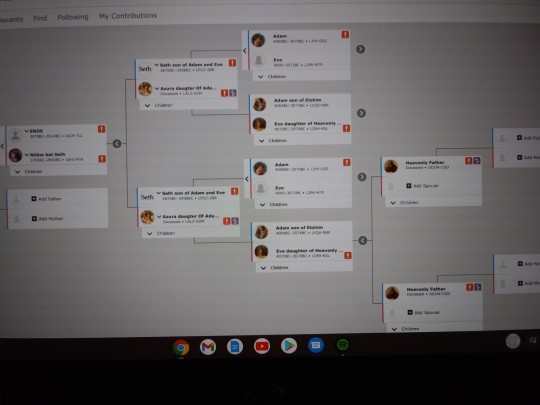
5 notes
·
View notes
Text
More about this blog.
In July 2021, I ended my WordPress version of this blog, as I was not having luck with finding "popular culture that focuses on genealogy, roots work, or family history" and put the blog, which had begun in June 2020 with gusto, on hiatus. I decided to reboot this idea on here, beginning with reprinting posts on the WordPress version of this blog as a start.
I encourage readers to tell me about any family history or genealogy themes in popular culture. Please mention it to me using any of the Tumblr tools, DM me on Twitter at @history_hermann, mention me in a tweet. I hope to hear from you.
0 notes
Text
Roots work in "Little Fockers"
Original video clip of this scene has since been made private
Reprinted from my Genealogy in Popular Culture WordPress blog. Originally published on July 27, 2020.
At the end of the 2010 film, Little Fockers, the parents of Gaylord "Greg" Focker present Jack Burns with a present, as shown in the above clip. They note that they have, using a sample of his DNA, traced his family roots. Bernie happily announces to Jack that he is 1/23 Israelite. Rozalin "Roz" Focker follows this up by welcoming him to "the tribe"! Although Jack is not as thrilled with this, he does thank them for their "gesture," with Bernie announcing that his Hebrew name is "Yakhov."
There is a lot more to this scene, which is even mentioned in the Wikipedia summary for the film. If we take the review for the film in the Evening Standard, which says that Bernie took some of his pubic hair and sent in for DNA testing, at face value, that is far from the reality of DNA testing. From what I know, DNA testing comes from your spit, not something like a hair! Why would any company want a store of people's pubic hair? That wouldn't even make sense. Anyway, the film was generally hated by critics, as it has a 9% Rotten Tomatoes rating and it earned three times its production budget, grossing over $310 million dollars!
This scene at the end of the film means that Jack and Greg have something in common because Jack notes earlier in the film that Greg is Jewish. Apart from that, this short scene does show genealogy in a funny, and positive, light. However, it does promote the idea that you can learn about your family genealogy all from a DNA test, and ignoring any possible research you would need in order to find original records, the key of any effort at family history research.
© 2020-2023 Burkely Hermann. All rights reserved.
#little fockers#comedy#film#popular culture#reviews#jewish#jewish culture#dna testing#dna#genealogy#family history
4 notes
·
View notes
Photo
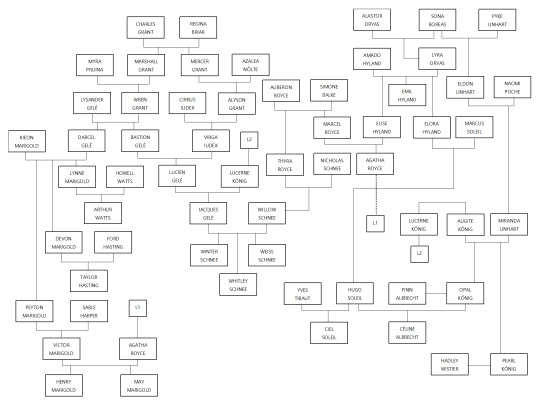
The Old Families of Atlas — A near-complete genealogy of the ancient families of the eponymous kingdom. Revised ca. 65 PB.
A higher-quality version can be found here.
14 notes
·
View notes
Text
The specter of the genealogist stereotype
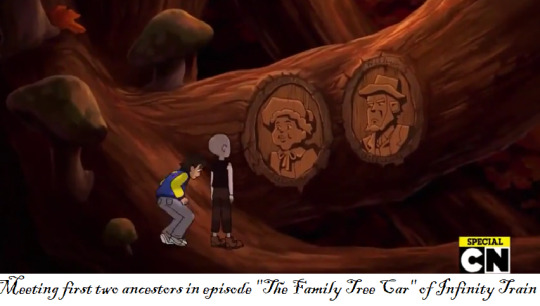
In 1982, Peter Andrews wrote in American Heritage that the "stereotype of the genealogist" has been familiar in popular culture, usually a "specific type, easily recognizable and faintly ridiculous," whether an elderly lady examining musty records or a "retired clergyman supplementing his pension." He adds that this meant that genealogy, itself, "carried an air of quackery about it." However, he says this is no longer the case. This is evident in some series I have written about on this blog before, like Amphibia, Infinity Train, Steven Universe, and throughout the recent reboot of Carmen Sandiego, to name a few posts, apart from last week's post reviewing genealogy in the Outlander series. This is not unique to those series, however. After all, as a podcast, BlackGenProLive, “genealogy and history are en vogue in popular culture, largely due to the number of television programs that are themed around the topics,” and noted in FamilyTree, with The Guardian even saying the current family history boom is due to the internet and TV. [1] Genealogy and family history is widespread in popular culture, with some authors, like Juliette Eames, creating customized children's family history books for people! As Thomas Jay Kemp put it in 2013, "you can find references to genealogy everywhere in America these days."
Reprinted from my Genealogy in Popular Culture WordPress blog. Originally published on April 12, 2021.
John D. Beatty of the Allen County Public Library Genealogy Center wrote in 2018 that genealogists before the 1970s especially only played "incidental roles in eccentric, snobby, or dysfunctional veins." He called the famous satirical painting by Grant Wood, Daughters of Revolution, criticizing the Daughters of the American Revolution (DAR), one of the first "artistic depictions of genealogists," and noted a few other examples prior to the 1970s:
In the 1942 film Castle in the Desert, Professor Gleason, a genealogist with a "moustache and walking stick," arrives at a a mansion of another affuelent man, and he is introduced as a genealogist who will “tell us about the monkeys in our family trees.” He later inquires about a notorious family and the wife of the affulent man gives him a warning, and he died after drinking a cocktail. The message of this film for such a superficial portrayal of a genealogist, is that genealogy is "something that only interested the upper classes and involved the lineages of famous families."
In a 1961 episode of the The Andy Griffith Show, “A Plaque for Mayberry," a town mayor summons a sheriff and his deputy, where they meet two elegantly dressed ladies of a Women’s Historical Society, declaring that they are "attempting to trace the descendant of a Revolutionary War hero, Nathan Tibbs, who had played a pivotal role at the Incident of Mayberry Bridge," which supposedly turned the tide of the war, wanting access to town records. Ultimately, while the genealoists serve only as incidental characters, the view of genealogical research as "a blue-blooded occupation and those who pursue it do so only to find links to prominent forebears" is communicated once more.
In a 1969 film, On Her Majesty’s Secret Service, James Bond goes undercover as a genealogist in order to "investigate Blofeld’s claims of nobility," and it again promotes a view of "genealogists as effete elitists, a campy profession that attracted only eccentrics."
In a 1969 comedy-drama, The Sterile Cuckoo, Pookie Adams is not a genealogist, but loves cemeteries, taking her boyfriend to a graveyard, extoling the "ability to find stories of the departed by reading their epitaphs." Beatty suggests that this shows that "cemeteries were not places that psychologically-healthy people ever visited."
youtube
After 1970, Beatty specifically holds up Roots as shattering the "notion that genealogy was only for the blue-blooded," and says that Alex Haley "embodied a sense of normalcy that had eluded earlier caricatures of genealogists." This is much better than the "magical quality" displayed in Harry Potter and the Order of the Phoenix by transphobic J.K. Rowling, with genealogy not explored at length in the film, none of the characters as genealogists, and the family genealogy is only a minor plot device. Contrast this with the controversial film, The Da Vinci Code, in 2006, where genealogical research plays a key role in the film itself,and various popular television shows [2] where ordinary ancestors are discussed. Even though research is often minimized, Beatty argues that these shows "provide some insight into research methodology." He concludes his article by saying that new portrayals reflect a change in genealogy over time, including further professionalization and democratization which makes it more available to the masses, even while he acknowledges no one should expect genealogists to become "commonplace on the silver screen" even if they show up more in television. He then hopes for complex and diverse genealogical characters in the future which are devoid of stereotypes and are problem-solvers.
Not accounting for documentaries with family history themes, like Children of the Inquisition, Birthplace, and August: Osage County as pointed out by Esther of MyHeritage, Helen, in an undated post on her genealogy blog, gives a few examples of genetic genealogy in popular culture:
The TV series Shameless. In a 2011 episode, "Nana Gallagher Had an Affair," an estranged mother tried to get custody of her son, but finds out that her ex-husband, Frank, is the biological father. In a 2016 episode "Own Your Shit," a brother takes another ancestry DNA test, showing that Carl is "part Native American, specifically Apache, securing him a reserved place." Then there's the 2017 episode "Got Bless Her Rotting Soul," where a family friend takes a DNA screening test, finding a "rare chromosomal pattern" which belongs to a fictional, and isolated, community in rural Kentucky.
In a 2018 episodes of the series, A Discovery of Witches, there is a study of genetics of various species, like demons, witches, and vampires, including an explanation of mitochondrial DNA
In a 2018 episode of the series, Bull, "The Missing Piece," a team assists a man after police identify him as a suspect using "investigative genetic genealogy via a match in a for-profit genetic genealogy company's customer database," and he finds out that he was adopted and had an identical twin brother, with the revelation of a twin brother resulting "in all charges against him being dropped."
In a 2018 episode of Blue Bloods, "Thicker Than Water," two detectives investigate an attempted murder after a daughter discovers, using a consumer DNA test that "the doctor is her biological father." Oh no, what a shock! In a later episode of Blue Bloods, "Family Secrets," in 2020, one character is puzzled by an "unknown first cousin match on his paternal side when he does a consumer DNA test for a school assignment."
In the series Grey's Anatomy, there is an episode in 2019, "Blood and Water," where a doctor orders a DNA test to "overcome her fears about her unknown genetic heritage when feeling pressured to have children." In another 2019 episode, "And Dream of Sheep," a co-worker is able to identify the birth mother of his friend using a "first cousin DNA match."
In a 2019 episode of The Good Fight, "The One where a Nazi Gets Punched," a law firm represents plaintiffs in a lawsuit against a "direct-to-consumer (DTC) genetic testing company."
In a 2019 episode of Nancy Drew, "The Hidden Staircase," a co-worker whips out a DNA test from her lock, asking her long-lost cousin for "some of his saliva for a DNA comparison to help her uncover her mother's mysterious past."
In a 2020 episode of Stumptown, "The Past and the Furious," a former marine and current PI, is hired to track down the birth parents of an adoptee.
In a 2020 episode of Vera, "Parent Not Expected," a DCI investigates the death of a young man who had recently found, through a DNA test, that "the man who raised him was not his biological father," with the admin of an online genealogy forum helping people identify their biological fathers.
"The laws governing inheritance are quite unknown; no one can say why the same peculiarity in different individuals of the same species, and in individuals of different species, is sometimes inherited and sometimes not so; why the child often reverts in certain characters to its grandfather or grandmother or other much more remote ancestor; why a peculiarity is often transmitted from one sex to both sexes, or to one sex alone, more commonly but not exclusively to the like sex"- Chapter 1 of The Origin of the Species
On a related note, in 2013, Daisy Hildyard in The Guardian listed ten literary works about ancestors, specifically pointing to Jerusalem by Jez Butterworth, "This Be the Verse" by Philip Larkin, The Rainbow by DH Lawrence, Bleak House by Charles Dickens, On the Origin of Species by Charles Darwin, "The Eternity of Nature" by John Clare, Brief Lives by John Aubrey, Henry IV Part I by William Shakespeare, Chronicles by Holinshed, and The Bible. Family history themes are even more widespread than this, however. Noel Murray, in 2015, talked about nine films focusing on family secrets, specifically Little White Lie, Secrets & Lies, A Family Thing, Lone Star, Siskel & Ebert, Capturing the Friedmans, The Celebration, Ida, Daughter from Danang, My Architect, and Stories We Tell. Others have written about genealogy in the realm of theater, of which were are various examples, [3] or noted some of the "most insane families in anime." On the latter, in a post for the Anime News Network, Gia Manry mentioned:
Arcana Famiglia (La storia della Arcana Famiglia), a mafia-style family
The Rozen Maidens (Rozen Maiden), sister dolls
The Ushiromiya Family (Umineko no Naku Koro ni), a huge clan
The Matou Family (Fate/stay night), creators of a system that serves as a central conflict throughout the franchise as a whole
Eastern Europe (Hetalia), composed of personified nations
Britannian Royal Family (Code Geass), has a family history "chock-full of colorful characters, political intrigue, and outrageous deaths"
The Hair Siblings (Bobobo-bo Bo-bobo), siblings fighting over their inheritance to the Hair Kingdom and are totally bonkers
The Ikari Family (Neon Genesis Evangelion), a clan which has a lot of internal family problems
Some others, like BYU Family History, lists family history themes in the White supremacist Back to the Future, and other films, like Lion King, Holes, Star Wars, My Big Fat Greek Wedding, Hitch, and Mulan. As one genealogist put it, "genealogy has changed; but yet it has not," with genealogists continuing to seek out "records hidden in courthouse attics and basements."
© 2021-2023 Burkely Hermann. All rights reserved.
Notes
[1] There may be some reviews of popular culture in Christine Scodari’s book Alternate Roots: Ethnicity, Race, and Identity in Genealogy Media, although I’m not sure. But I'll try to get the book and let you know what I think, writing about it on here.
[2] Like Who Do You Think You Are, Genealogy Roadshow, and Finding Your Roots. Some scholars have criticized what they call "selective rememberance" on these TV shows.
[3] In one post, Sydney Orton,talks about family history themes in Ragtime, Bandstand, The Pirate Queen, Miss Saigon, Finding Neverland, Evita, Bonnie & Clyde, Fiddler on the Roof, and Big River. In another post, she focuses on similar themes in Come From Away, 1776, Allegiance, Anastasia, 9 to 5, Les Miserables, Newsies, A Tale of Two Cities, Bright Star, Memphis, West Side Story, Titanic: The Musical, The Sound of Music, and The Civil War.
#amphibia#infinity train#outlander#steven universe#carmen sandiego#the guardian#family trees#ancestors#genealogy#dar#harry potter#jk rowling#transphobia#roots tv show#anime#anime news network#Youtube#dna#dna testing#family history#roots work
8 notes
·
View notes
Text
Mira and a town of relatives

Mira and her father in the episode "The Great Diwali Mystery"
Mira, Royal Detective is one of my favorite series. I have to write about it here on this blog because unlike some other shows, the town where this Indian-inspired series is set, Jalpur, the protagonist, Mira, appears to be related to...everyone! This is like any small town. Anyway, I'd like to break it down for you all, because family ties and the value of family is central to this series, unlike any other that I have ever seen.
Reprinted from my Genealogy in Popular Culture WordPress blog. Originally published on June 2, 2021.
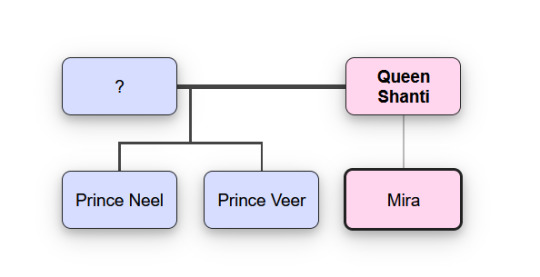
We do not currently know who Shanti's husband is, or if he is still alive. I created this using one of my favorite sites for creating family trees, Family Echo
Let's start with Mira, herself. She was appointed by Queen Shanti to be the royal detective in the city, and she considers her to be like a daughter. Shanti herself has two sons: Prince Neel, a brilliant and talented inventor, often flying around the city in his flycycle or some other invention, and Prince Veer, the aspiring King of Jalpur. Neel has a crush on Mira. We also know that he has a grand-grandmother who was an inventor and built a submarine, as shown in a recent episode, and has great aunt, Rupa. As for Mira, she has two friends, mongooses who help her out on cases: Mikku and Chikku. They are brothers and have two cousins, who are also mongooses: Preeti and Neeti, who are skilled in rope gymnastics. [1]
Mira, however, is NOT directly related to Queen Shanti. Her father is Sahil, who calls her "beti" when talking to her. Two of her friends, Priya and Meena, are sisters, and her cousins, as is Chotu, a younger brother of Priya and Meena (also known as Mina). Their mother is Pushpa, who is also Mira's aunt. Presumably, Kamala is also her cousin, who has a younger sister named Dimple. The same can, possibly, be said for her friends Pinky, Dhruv Sharma, and Sandeep. Apart from them are two brothers, Ranjeet and Manjeet, a music teacher (Sanjeev Joshi), who are her friends. [2] In a few episodes, the royal Nayapuram family appears, comprised of a king, queen, and their daughter, Princess Shivani.
In order to explain this, I came up with this chart created via one originally shared by Kathleen Brandt, a genealogist who wrote that it is "one of the biggest errors made when referencing cousin relationships."

So, we currently do not know the parents of Kamala and Dimple, Dhruv (whose surname is Sharma), Sandeep, or Pinky. But, it is possible that at least one of their parents is a brother or sister of Sahil and Pushpa. There are also many, many unnamed uncles that Mira meets in the town, meaning that they may be some of these people. Some of these parents may have been featured in some episodes but I'm not aware of them. That is definitely a possibility. Saying all of this, it is possible that Mira is calling older men she meets in Jalpur "Uncle" since, as some have noted, "kids routinely call complete strangers “Uncle” and “Aunty”" even if they aren't related. As Times of India noted in 2015, it is "very common" for those in India to call those older than themselves "Aunty" or "Uncle," with this done out of "respect for the elderly or for fellow humans." That could be the case here, even though the terms can also be used for those that someone is related to, by family ties.
Even so, I think that Pushpa is Mira's aunt, since her name in the show is literally "Auntie Pushpa." [3] In the end, I'll keep an eye on this series and possible write another post on this show later.
© 2021-2023 Burkely Hermann. All rights reserved.
Notes
[1] In a recent episode, "The Case of the Vanishing Picnic," Mikku says "its not every day there are cousins that visit from the big city," referring to Neeti and Preeti, showing Mira secret family recipes they have prepared.
[2] This isn't accounting for the Palace Tailor, the two bandits (Manish and Poonam), Ram Sing Ji, and Deputy Oosha who are likely not related to Mira.
[3] In the episode "The Case of the Lost Treehouse," Mira's pa says "there's the tapestry your Auntie Pushpa made for the wall," making it clear this is the case.
© 2020-2023 Burkely Hermann. All rights reserved.
#mira royal detective#indian culture#disney animation#disney#uncles#adopted daughter#adoption#genealogy#family history#family trees#roots work#aunts#reviews
2 notes
·
View notes
Text
The twisted family stories and connections in Outlander
Late last year, Janet Lafleur, told me in a chat, said that "Outlander’s central plot line wouldn’t have been possible without the characters doing genealogical research." In an effort to make this blog more active and continue pop culture reviews, I decided to write about it in this post, despite the challenges with making a family tree due to time travel (similar to Futurama in that sense), but not different universes like Batman. Chris Paton wrote about this back in 2017, noting that a family tree for the series is available as part of the extended ebook content for the eighth book in the series, Written in My Own Heart's Blood, and it can be downloaded from the Random House website and reprinted later in this post. Paton noted that Outlander "starts off as a fantasy time travel series" and that he is "yet to meet a genie that hasn't become a fan." Even Vulture had a whole article about a family tree of the show's characters. So I'm building upon existing research and discussion on this topic.
Reprinted from my Genealogy in Popular Culture WordPress blog. Originally published on April 5, 2021.
Let's start with the above tree, which shows marriages, out-of-wedlock affairs, divorces, children, foster children, and stepchildren. With the time travel begun by the show's protagonist, Claire, it makes these relationships more complicated. While the tree mentioned earlier would appear to have some errors, reading it closely, that is only because of the way it is set up. So, its better go through family by family.
Beauchamp Family

Due to time travel, Briana Randall is NOT the daughter of Claire and her husband in the 20th century, Frank Randall, but is rather the child of Claire and Jamie Fraser, a Scottish soldier and landowner. Claire's parents are the same, although Quentin Lambert Beauchamp was Claire's guardian and raised her.
Fraser of Lovat
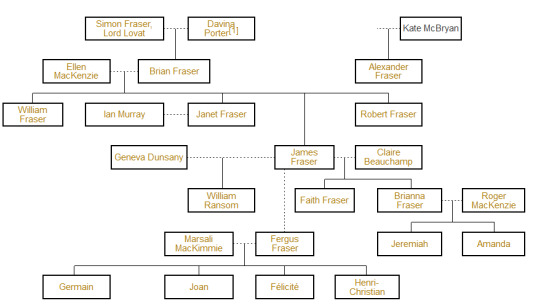
This clan in the Scottish Highlands includes "bastards" named Brian Fraser and Alexander Fraser, while Jamie Fraser had a one-night stand with Geneva Dunsany, which resulted in their son, William. This tree specifically notes the relationships Jamie has to his biological and adopted children, and their moms. It is worth poining out that Jamie had married Claire Fraser and Laoghaire MacKenzie, but not Geneva Dunsany, with the second marriage declared invalid after Claire returns, with Marsali and Joan being daughters from that marriage. A French child pickpocket named Fergus was adopted by Jamie, resulting in him taking the Fraser surname. As such, Jamie has three biological children (Faith, Brianna, and William), and three adopted/step-children (Fergus, Marsali, and Joan). That's one big family, to say the least!
Grey Family
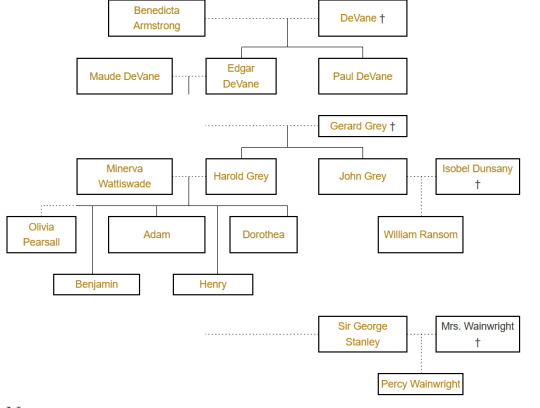
While this family has a major part in some of the spin-off novels, it is a minor one in the series as a whole. Even so, there are a lot of relationships caused by Benedicta Armstrong's three marriages, first to Captain DeVane at age 15, second to Gerald Grey at age 21, and third to Sir George Stanley in 1758, the latter who is a widower two times before. The first wife of Hall was a French woman named Esmé Dufresne, Benjamin Grey married another woman and had a son with her, while Dorothea Grey married Denzell Hunter.
MacKenzies of Leoch
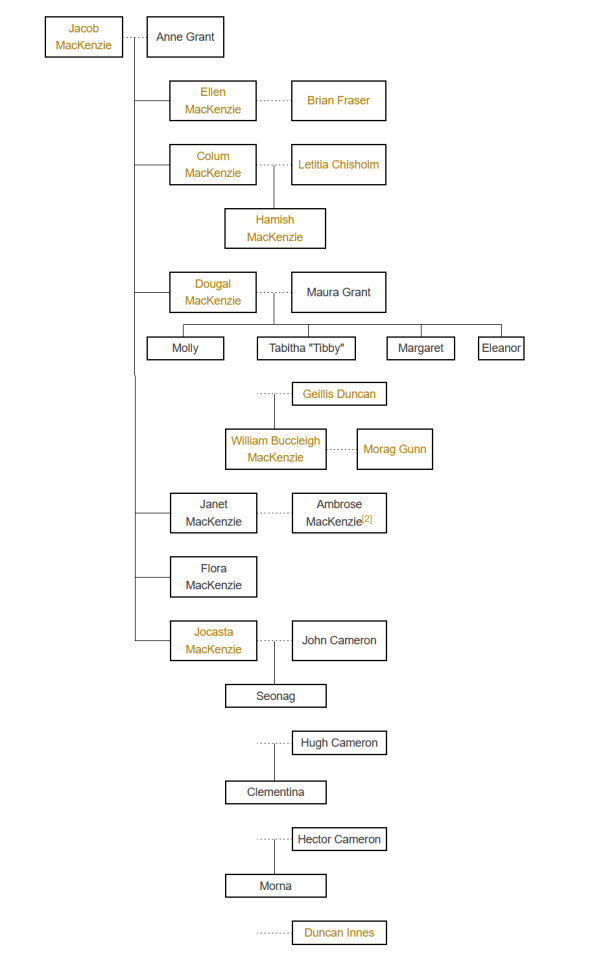
This fictional Scottish clan which dispersed after the failed Jacobite Rising of 1745.In this tree, Hamish was the biological son of Dougal MacKenzie, though only a few people ever knew this. Additionally, Dougal and Geillis were lovers and never married, with their son was born out of wedlock and never acknowledged. That's a few important elements.
Murray Family
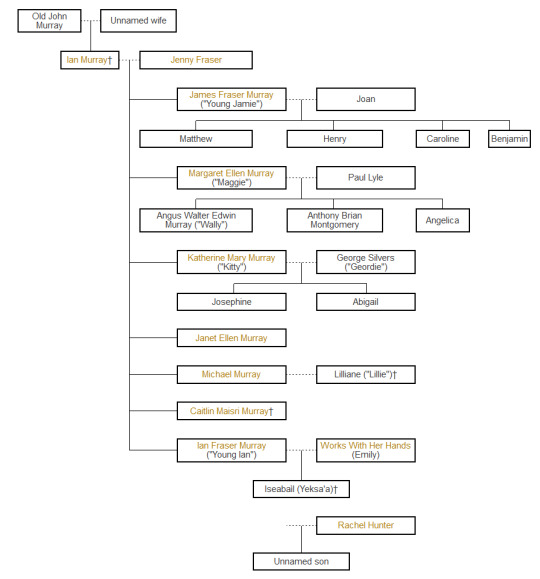
A few important notes on this family. For one, Angus Walter Edwin Murray Lyle (also known as "Wally") is the biological son of Geordie Carmichael, brother of Paul Lyle, because of a rape! Yikes. Additonally, Digger was the son of Ian's Spirit, and Ian names Emily's son (Digger) the Swiftest of Lizards. This means it is ambigious whether Swiftest of Lizards is Ian's biological son or rather that the child is Ian's son by the Mohawk way of thinking, meaning that a man's spirit must overcome a woman's spirit to "conceive a child" as stated on the fandom. I'm not sure whether this is hinting at some sort of gender ambiguity here, or if I'm reading into this more. There is one gay character in the series, Lord John Grey, but he is closeted at a time that he could be hanged for being outwardly gay. [1]
Randall Family

There are a number of interesting notes. For one, while Denys Alexander was the biological child of Alexander, he is actually, legally, the son of Jonathan, Mary Hawkins' husband. Additionally, after her first husband died, Mary Hawkins Randall remarried to Robert Isaacs, and in turn he adopted Denys. As such, he took the name Denys Randall-Isaacs. In another interesting time travel note, even though Brianna Mackenzie was the biological child of Jamie Fraser, she was raised by Frank Randall.
Roger Wakefield MacKenzie's Family Tree

For one, this tree is interesting because William and Sarah MacKenzie are not the biological parents of William Buccleigh. He is, in fact, the illegitimate son of Dougal MacKenzie and Geillis Duncan. Additionally, the three intervening generations from Jeremiah Buccleigh to Jeremiah Walter are not show and are represented by a dotted line on this chart.
© 2021-2023 Burkely Hermann. All rights reserved.
Notes
[1] Diana Gabaldon wrote that "he's also a gay man, in a time when to be homosexual was a capital offense, and Lord John has more than most to lose by discovery" about John, who is the star of Lord John novel series, a spinoff of the Outlander novel series. Another reviewer called Grey "a gay man in a time when that particular predilection could get one hanged...a man of honor and deep affections — whether returned or not." His orientation was also commented on by NewNowNext, MTV, and GLAAD. Gabaldon also went out of her way to say that a sadistic character, Black Jack Randall was NOT gay, which is interesting to say the least.
#outlander#family trees#genealogy#family history#step families#blended family#time travel#futurama#criminals#pickpocket#1750s#scottish#charts#glaad#newnownext#mtv#closeted#gayness#family conflict#reviews
0 notes
Text
Family secrets, family trees, and family history in Spellbound
On October 13, Libby Copeland wrote an interesting article in Psychology Today about the interest of Americans in genealogy, saying that it has become a cultural phenomenon and a big business, noting her book on the topic, titled The Lost Family: How DNA Testing Is Upending Who We Are. She noted that for much of U.S. history it has been seen as either "a worthy middle-class endeavor" or something to "divide people into a hierarchy of stations based on race and class," which changed in the later 20th century as the pursuit of family history became broader, with more Americans understanding themselves and their ancestors. Copeland also stated that the desire to look backward is sometimes out of a "sense of rootlessness," storytelling, explanation of family traits, and hoping the past can explain the present, while Black people may be "blocked from knowledge of the past by the paucity of records about their enslaved ancestors." She also stated that currently, we look because of a fear of current circumstances with the COVID pandemic, with Copeland stating that the present is time to ask questions, reckon with our past and that many of us are "faced with profound surprises about ourselves and our families, answers to questions we never even realized we were asking." In this post, I'll explore how this has manifested itself in some of my favorite webcomics, Spellbound, by Rose Luxey, otherwise known as "Ronce."
Reprinted from my Genealogy in Popular Culture WordPress blog. Originally published on March 15, 2021.
It begins in issue 86, aptly titled "Family history." One of the protagonists, Eglantine "Egg," comes to the mess hall alongside her roommate Ninon, asks her friend Faustine about what it means that her family is experimenting with magic, "legally speaking." Faustine explains that her family can be traced to the Great Magic Wars, with her father from one of the leading families. Right after that, we see a family tree, as shown below:

Following this, Faustine explains that her ancestors were part of a family which brought destruction in their quest for more power and realizing her connection to that past, that it is not so distant anymore. The parallel I can think of are White people who have slaveowners as ancestors, who dismiss it as far in the past, even though it is part of their heritage, something which should be acknowledged. Egg is disturbed by this, as shown in the next issue of the webcomic, with Faustine admitting it isn't good to read about terrible things her uncle did in the past, and alter beginning to tell her about the different kinds of magic.
Sadly, this seems to be the only time roots or genealogy come up in the webcomic. However, this doesn't mean the webcomic is bad or anything. Rather, it focused on more important issues, interpersonal conflicts, identity crisis, friendship, love, depression, familial neglect, acceptance, and the like. And all of those issues are interconnected with the roots work that each of use do as genealogists. So, in that way, it comes full circle.
© 2021-2023 Burkely Hermann. All rights reserved.
#webcomics#webtoon#spellbound#covid 19#covid19#pandemic#lineage#ancestors#slaveowners#whiteness#magic#roots work#reviews#genealogy#family history
0 notes